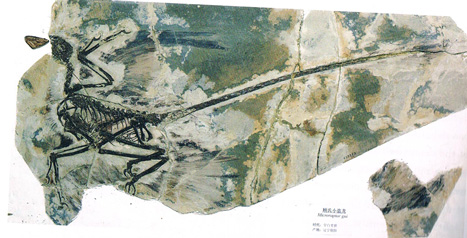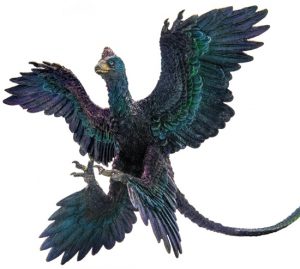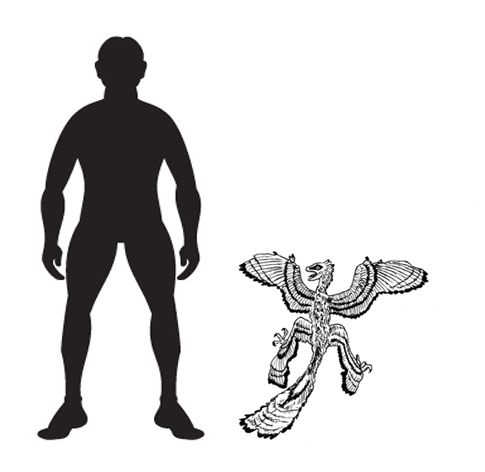Wind Tunnel Tests Provide New Data on the Evolution of Powered Flight in Birds
Thanks to some amazing dinosaur fossil discoveries that have been made in recent years, most notably from the Liaoning Province of northern China, palaeontologists have been able to study a number of feathered theropod dinosaurs and primitive birds. Such studies have shed light on the evolution of feathers and provided information on the origins of powered flight. However, little work has been done on testing the flight abilities of these early Cretaceous creatures. The flight performance, stability and aerodynamics of one theropod dinosaur, a genus called Microraptor, one of the smallest dinosaurs known to science, has been put to the test by a team of researchers at Southampton University (United Kingdom).
Microraptor
About two dozen or so specimens of Microraptor have been excavated from the fine grained sedimentary deposits of Liaoning Province. Many of these beautifully preserved fossils show that this little dinosaur had asymmetrical flight feathers on both its arms and its legs. The body was covered in downy feathers and this carnivore, which probably weighed around 1,000 grammes, had a long, rigid tail that sported an array of feathers too. In essence the feather covered limbs and tail provided Microraptor with five potential lifting surfaces, it essentially had five wings.
The Fossilised Remains of a Microraptor
The scientists from Southampton University built a full scale model of Microraptor in order to test the flight abilities of this “flying dinosaur”. Tests in a wind tunnel suggest that the fore-limb dominated bird flight passed through an evolutionary stage of four-winged flight (terapteryx). The research into Microraptor indicates that this dinosaur’s anatomy represents an important stage in the development of gliding leading on to powered flight.
Wind Tunnel Tests
The wind test results show that Microraptor would have been most stable gliding when large amounts of lift was generated from its wings. Flight simulations demonstrate that this behaviour had advantages since this high lift coefficient allows for slow glides, which can be achieved with less height loss. For gliding down from low elevations, such as trees, this slow, and aerodynamically less efficient flight was the gliding strategy that results in minimal height loss and longest glide distance, a most efficient form of movement.
For many years, the position and orientation of Microraptor’s legs and wings as it glided had been debated. However, the leg position and wing shape turns out to be largely irrelevant, the wind tunnel tests indicate that changes in these variables make little difference to the dinosaur’s ability to fly.
The Evolution of Flight
Senior Lecturer in Vertebrate Palaeontology at the University, Dr Gareth Dyke, a co-author of this new study commented:
“Significant to the evolution of flight, we show that Microraptor did not require a sophisticated, ‘modern’ wing morphology to undertake effective glides, as the high-lift coefficient regime is less dependent upon detail of wing morphology. This is consistent with the fossil record, and also with the hypothesis that symmetric ‘flight’ feathers first evolved in dinosaurs for non-aerodynamic functions, later being adapted to form aerodynamically capable surfaces.”
Model of a Microraptor to Test Aviation Capabilities
The black Microraptor model (above) is from the PNSO model series, to view the range of PNSO prehistoric animal models in stock at Everthing Dinosaur: PNSO Age of Dinosaurs Models and Figures.
The research has been written up for inclusion in the next edition of the academic journal “Nature Communications”.
Dr Roeland de Kat, the study’s co-author and a Research Fellow in the Aerodynamics and Flight Mechanics Research Group (Southampton University), added:
“What interests me is that aerodynamic efficiency is not the dominant factor in determining Microraptor’s glide efficiency. However, it needs a combination of a high lift coefficient and aerodynamic efficiency to perform at its best.”
New Science on an Early Cretaceous Dinosaur
This is the first time such wind tunnel tests have been carried out on such a sophisticated model representing a Microraptor, the model even has real feathers applied to its limbs, these feathers provide detailed information on the effect of air currents and on drag, helping the researchers to gain a much deeper understanding of the flight capabilities of this Early Cretaceous dinosaur. Further details of this research will be presented at a conference celebrating the importance of British and Chinese dinosaur fossil discoveries being held later this week at the National Oceanography Centre (Southampton).
A Scale Drawing of Microraptor
Picture credit: Everything Dinosaur









Leave A Comment